Organizational Culture and Management in MGNT 803, Semester 1 Report
VerifiedAdded on 2022/10/12
|7
|2190
|173
Report
AI Summary
This report, prepared for the MGNT 803 Organizational Behaviour and Management course, delves into the critical role of organizational culture in shaping an organization's future. It draws upon multiple sources, including Warrick (2016), Warrick et al. (2016), Abu-Jarad & Yusof (2010), and Cameron & Quinn (2011), to explore various facets of organizational culture. The report examines the impact of culture on employee performance, job satisfaction, and overall organizational success, highlighting the characteristics of high and low-performance cultures. It also discusses the relationship between organizational culture and performance, emphasizing the importance of strong shared values and ethical practices. Furthermore, the report addresses the need for managing organizational cultural change in response to external environmental shifts, underscoring the potential for cultural barriers to hinder progress. Practical implications for managers include fostering a sound organizational culture, ensuring customer satisfaction, and facilitating positive change management. The report concludes by emphasizing the importance of organizational culture as a foundation for a thriving future, highlighting its influence on employee relations, performance, and the ability to adapt to change. References are provided, including Alvesson (2013), the assignment brief provided is also included in the solution, with a word count of 815.
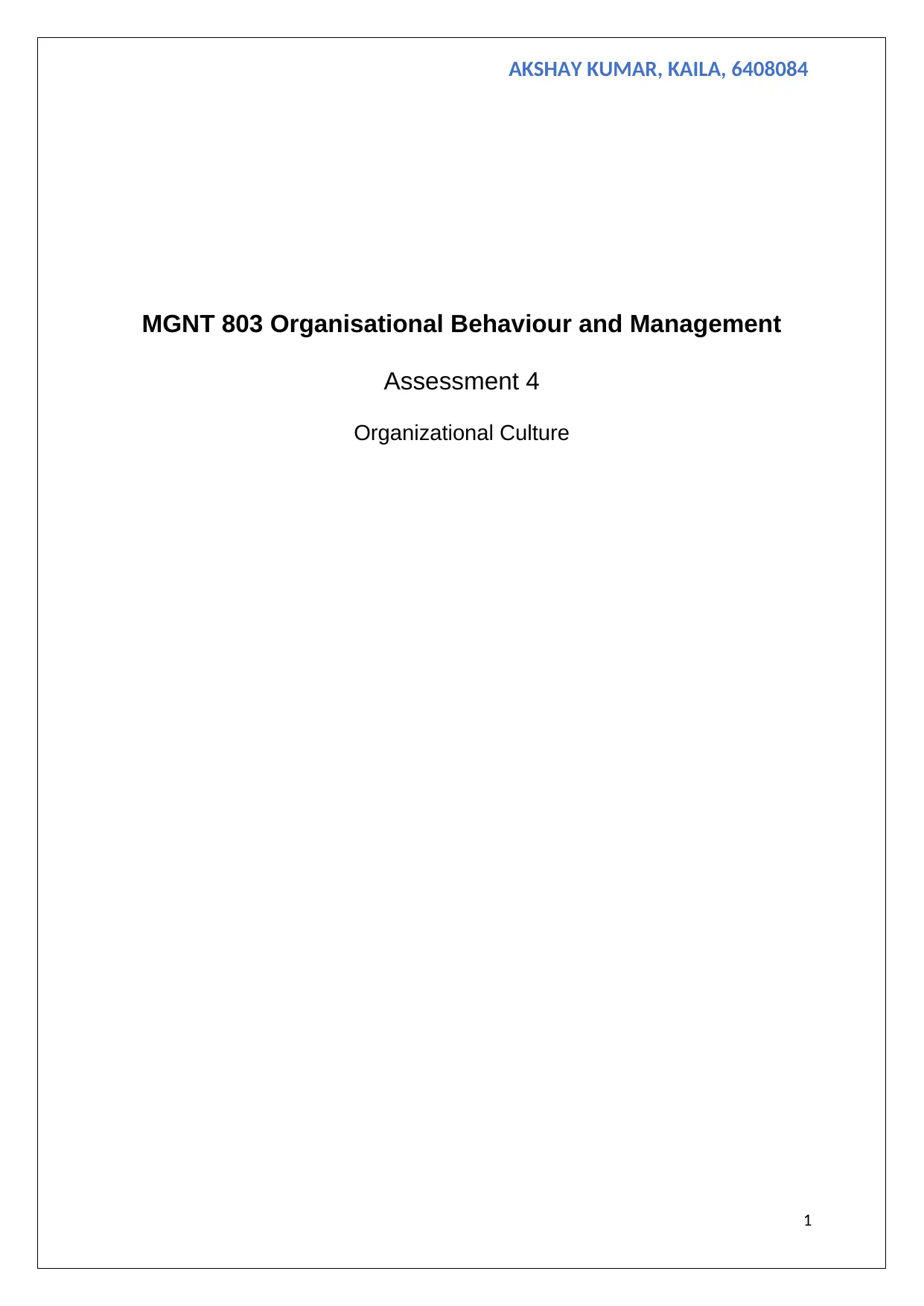
AKSHAY KUMAR, KAILA, 6408084
MGNT 803 Organisational Behaviour and Management
Assessment 4
Organizational Culture
1
MGNT 803 Organisational Behaviour and Management
Assessment 4
Organizational Culture
1
Paraphrase This Document
Need a fresh take? Get an instant paraphrase of this document with our AI Paraphraser
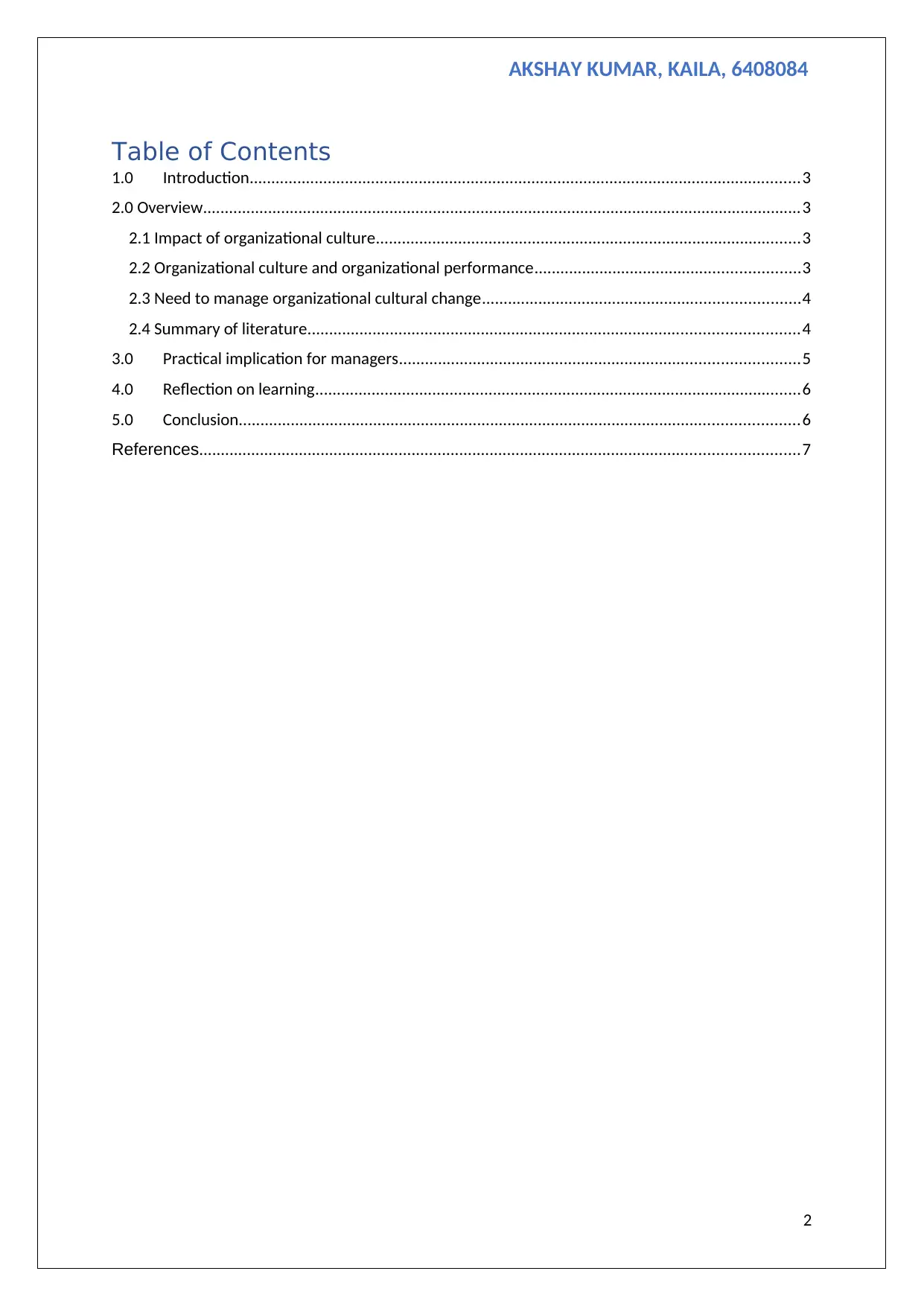
AKSHAY KUMAR, KAILA, 6408084
Table of Contents
1.0 Introduction...............................................................................................................................3
2.0 Overview..........................................................................................................................................3
2.1 Impact of organizational culture..................................................................................................3
2.2 Organizational culture and organizational performance.............................................................3
2.3 Need to manage organizational cultural change.........................................................................4
2.4 Summary of literature.................................................................................................................4
3.0 Practical implication for managers............................................................................................5
4.0 Reflection on learning................................................................................................................6
5.0 Conclusion.................................................................................................................................6
References..........................................................................................................................................7
2
Table of Contents
1.0 Introduction...............................................................................................................................3
2.0 Overview..........................................................................................................................................3
2.1 Impact of organizational culture..................................................................................................3
2.2 Organizational culture and organizational performance.............................................................3
2.3 Need to manage organizational cultural change.........................................................................4
2.4 Summary of literature.................................................................................................................4
3.0 Practical implication for managers............................................................................................5
4.0 Reflection on learning................................................................................................................6
5.0 Conclusion.................................................................................................................................6
References..........................................................................................................................................7
2
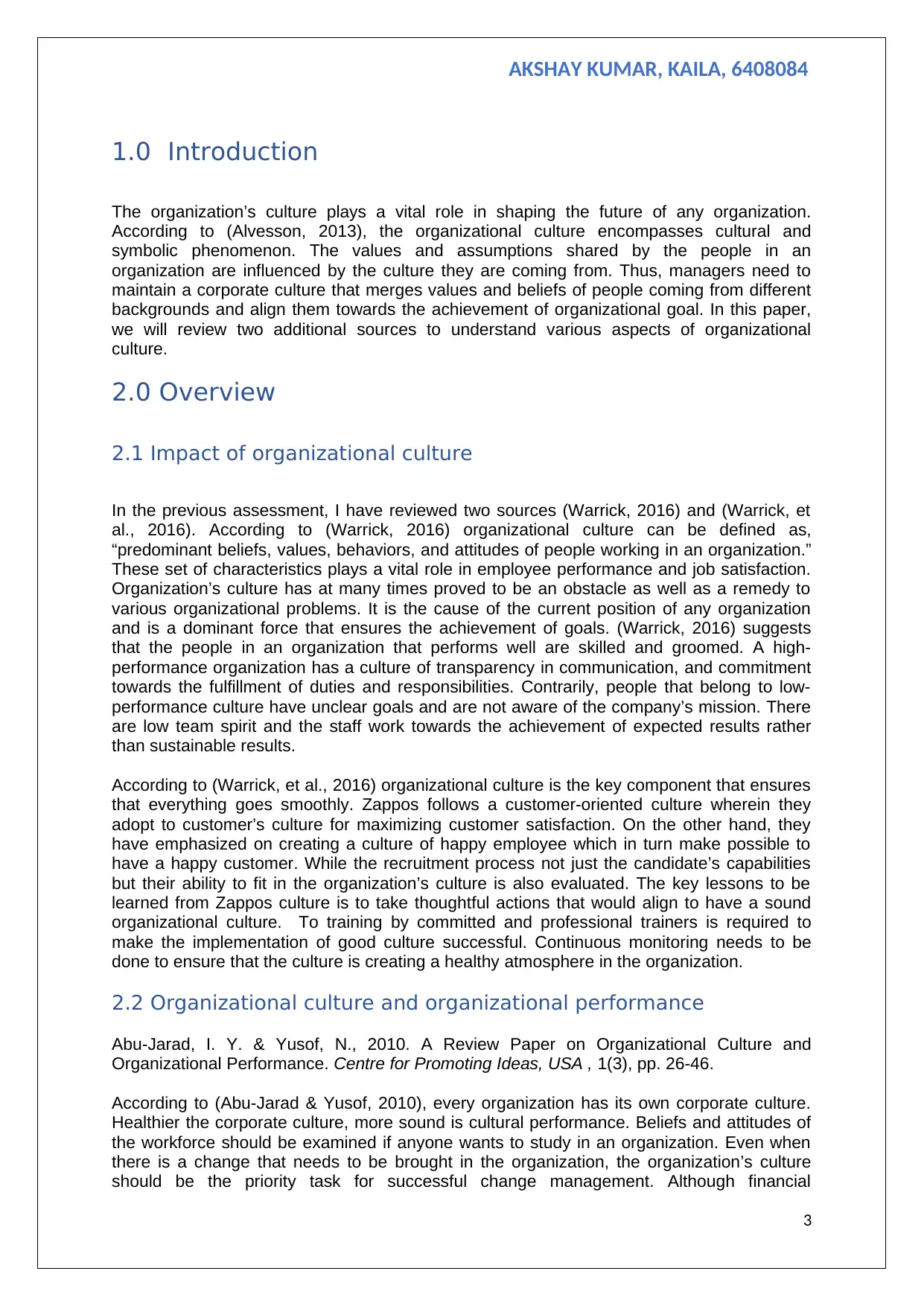
AKSHAY KUMAR, KAILA, 6408084
1.0 Introduction
The organization’s culture plays a vital role in shaping the future of any organization.
According to (Alvesson, 2013), the organizational culture encompasses cultural and
symbolic phenomenon. The values and assumptions shared by the people in an
organization are influenced by the culture they are coming from. Thus, managers need to
maintain a corporate culture that merges values and beliefs of people coming from different
backgrounds and align them towards the achievement of organizational goal. In this paper,
we will review two additional sources to understand various aspects of organizational
culture.
2.0 Overview
2.1 Impact of organizational culture
In the previous assessment, I have reviewed two sources (Warrick, 2016) and (Warrick, et
al., 2016). According to (Warrick, 2016) organizational culture can be defined as,
“predominant beliefs, values, behaviors, and attitudes of people working in an organization.”
These set of characteristics plays a vital role in employee performance and job satisfaction.
Organization’s culture has at many times proved to be an obstacle as well as a remedy to
various organizational problems. It is the cause of the current position of any organization
and is a dominant force that ensures the achievement of goals. (Warrick, 2016) suggests
that the people in an organization that performs well are skilled and groomed. A high-
performance organization has a culture of transparency in communication, and commitment
towards the fulfillment of duties and responsibilities. Contrarily, people that belong to low-
performance culture have unclear goals and are not aware of the company’s mission. There
are low team spirit and the staff work towards the achievement of expected results rather
than sustainable results.
According to (Warrick, et al., 2016) organizational culture is the key component that ensures
that everything goes smoothly. Zappos follows a customer-oriented culture wherein they
adopt to customer’s culture for maximizing customer satisfaction. On the other hand, they
have emphasized on creating a culture of happy employee which in turn make possible to
have a happy customer. While the recruitment process not just the candidate’s capabilities
but their ability to fit in the organization’s culture is also evaluated. The key lessons to be
learned from Zappos culture is to take thoughtful actions that would align to have a sound
organizational culture. To training by committed and professional trainers is required to
make the implementation of good culture successful. Continuous monitoring needs to be
done to ensure that the culture is creating a healthy atmosphere in the organization.
2.2 Organizational culture and organizational performance
Abu-Jarad, I. Y. & Yusof, N., 2010. A Review Paper on Organizational Culture and
Organizational Performance. Centre for Promoting Ideas, USA , 1(3), pp. 26-46.
According to (Abu-Jarad & Yusof, 2010), every organization has its own corporate culture.
Healthier the corporate culture, more sound is cultural performance. Beliefs and attitudes of
the workforce should be examined if anyone wants to study in an organization. Even when
there is a change that needs to be brought in the organization, the organization’s culture
should be the priority task for successful change management. Although financial
3
1.0 Introduction
The organization’s culture plays a vital role in shaping the future of any organization.
According to (Alvesson, 2013), the organizational culture encompasses cultural and
symbolic phenomenon. The values and assumptions shared by the people in an
organization are influenced by the culture they are coming from. Thus, managers need to
maintain a corporate culture that merges values and beliefs of people coming from different
backgrounds and align them towards the achievement of organizational goal. In this paper,
we will review two additional sources to understand various aspects of organizational
culture.
2.0 Overview
2.1 Impact of organizational culture
In the previous assessment, I have reviewed two sources (Warrick, 2016) and (Warrick, et
al., 2016). According to (Warrick, 2016) organizational culture can be defined as,
“predominant beliefs, values, behaviors, and attitudes of people working in an organization.”
These set of characteristics plays a vital role in employee performance and job satisfaction.
Organization’s culture has at many times proved to be an obstacle as well as a remedy to
various organizational problems. It is the cause of the current position of any organization
and is a dominant force that ensures the achievement of goals. (Warrick, 2016) suggests
that the people in an organization that performs well are skilled and groomed. A high-
performance organization has a culture of transparency in communication, and commitment
towards the fulfillment of duties and responsibilities. Contrarily, people that belong to low-
performance culture have unclear goals and are not aware of the company’s mission. There
are low team spirit and the staff work towards the achievement of expected results rather
than sustainable results.
According to (Warrick, et al., 2016) organizational culture is the key component that ensures
that everything goes smoothly. Zappos follows a customer-oriented culture wherein they
adopt to customer’s culture for maximizing customer satisfaction. On the other hand, they
have emphasized on creating a culture of happy employee which in turn make possible to
have a happy customer. While the recruitment process not just the candidate’s capabilities
but their ability to fit in the organization’s culture is also evaluated. The key lessons to be
learned from Zappos culture is to take thoughtful actions that would align to have a sound
organizational culture. To training by committed and professional trainers is required to
make the implementation of good culture successful. Continuous monitoring needs to be
done to ensure that the culture is creating a healthy atmosphere in the organization.
2.2 Organizational culture and organizational performance
Abu-Jarad, I. Y. & Yusof, N., 2010. A Review Paper on Organizational Culture and
Organizational Performance. Centre for Promoting Ideas, USA , 1(3), pp. 26-46.
According to (Abu-Jarad & Yusof, 2010), every organization has its own corporate culture.
Healthier the corporate culture, more sound is cultural performance. Beliefs and attitudes of
the workforce should be examined if anyone wants to study in an organization. Even when
there is a change that needs to be brought in the organization, the organization’s culture
should be the priority task for successful change management. Although financial
3
⊘ This is a preview!⊘
Do you want full access?
Subscribe today to unlock all pages.

Trusted by 1+ million students worldwide
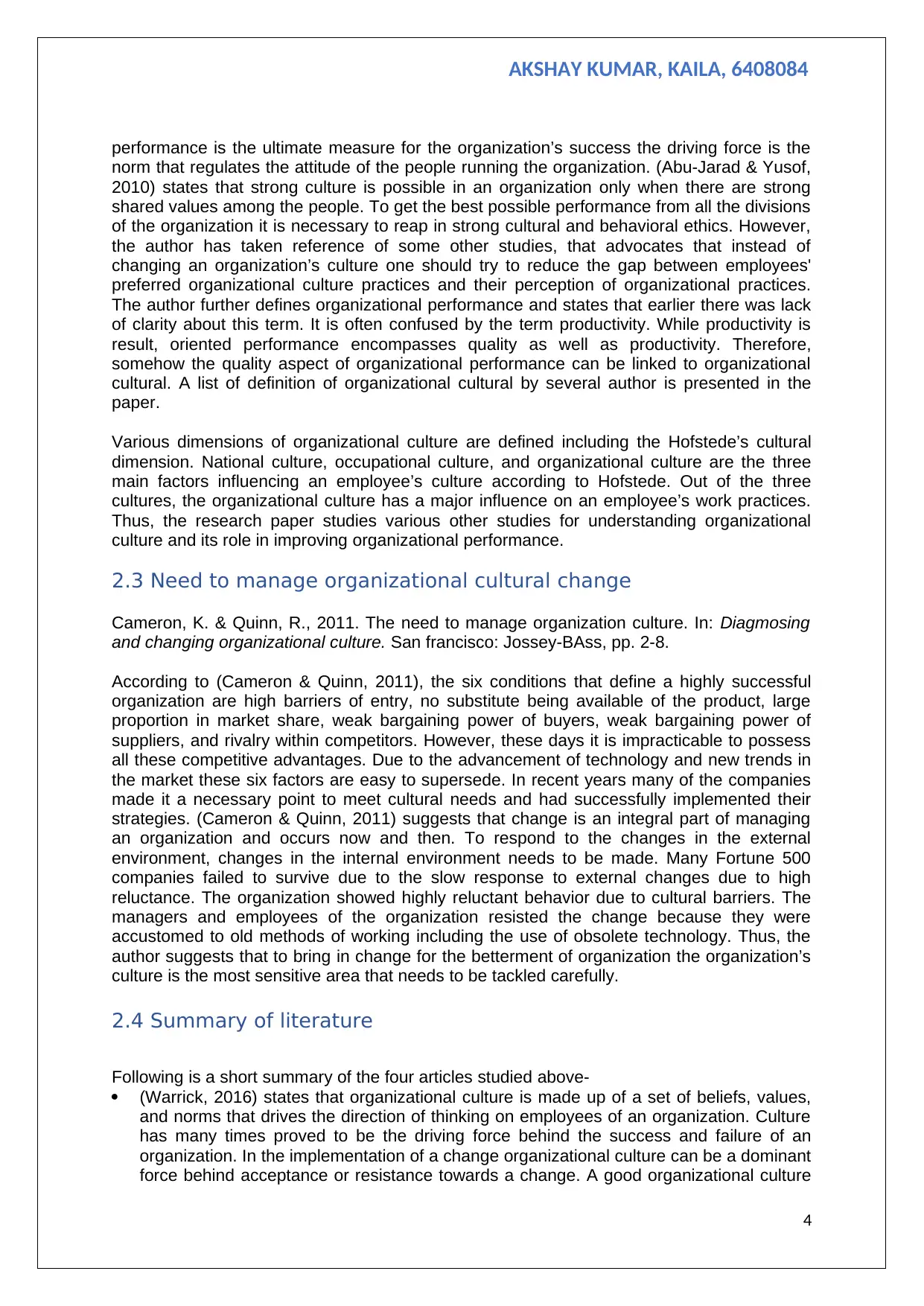
AKSHAY KUMAR, KAILA, 6408084
performance is the ultimate measure for the organization’s success the driving force is the
norm that regulates the attitude of the people running the organization. (Abu-Jarad & Yusof,
2010) states that strong culture is possible in an organization only when there are strong
shared values among the people. To get the best possible performance from all the divisions
of the organization it is necessary to reap in strong cultural and behavioral ethics. However,
the author has taken reference of some other studies, that advocates that instead of
changing an organization’s culture one should try to reduce the gap between employees'
preferred organizational culture practices and their perception of organizational practices.
The author further defines organizational performance and states that earlier there was lack
of clarity about this term. It is often confused by the term productivity. While productivity is
result, oriented performance encompasses quality as well as productivity. Therefore,
somehow the quality aspect of organizational performance can be linked to organizational
cultural. A list of definition of organizational cultural by several author is presented in the
paper.
Various dimensions of organizational culture are defined including the Hofstede’s cultural
dimension. National culture, occupational culture, and organizational culture are the three
main factors influencing an employee’s culture according to Hofstede. Out of the three
cultures, the organizational culture has a major influence on an employee’s work practices.
Thus, the research paper studies various other studies for understanding organizational
culture and its role in improving organizational performance.
2.3 Need to manage organizational cultural change
Cameron, K. & Quinn, R., 2011. The need to manage organization culture. In: Diagmosing
and changing organizational culture. San francisco: Jossey-BAss, pp. 2-8.
According to (Cameron & Quinn, 2011), the six conditions that define a highly successful
organization are high barriers of entry, no substitute being available of the product, large
proportion in market share, weak bargaining power of buyers, weak bargaining power of
suppliers, and rivalry within competitors. However, these days it is impracticable to possess
all these competitive advantages. Due to the advancement of technology and new trends in
the market these six factors are easy to supersede. In recent years many of the companies
made it a necessary point to meet cultural needs and had successfully implemented their
strategies. (Cameron & Quinn, 2011) suggests that change is an integral part of managing
an organization and occurs now and then. To respond to the changes in the external
environment, changes in the internal environment needs to be made. Many Fortune 500
companies failed to survive due to the slow response to external changes due to high
reluctance. The organization showed highly reluctant behavior due to cultural barriers. The
managers and employees of the organization resisted the change because they were
accustomed to old methods of working including the use of obsolete technology. Thus, the
author suggests that to bring in change for the betterment of organization the organization’s
culture is the most sensitive area that needs to be tackled carefully.
2.4 Summary of literature
Following is a short summary of the four articles studied above-
(Warrick, 2016) states that organizational culture is made up of a set of beliefs, values,
and norms that drives the direction of thinking on employees of an organization. Culture
has many times proved to be the driving force behind the success and failure of an
organization. In the implementation of a change organizational culture can be a dominant
force behind acceptance or resistance towards a change. A good organizational culture
4
performance is the ultimate measure for the organization’s success the driving force is the
norm that regulates the attitude of the people running the organization. (Abu-Jarad & Yusof,
2010) states that strong culture is possible in an organization only when there are strong
shared values among the people. To get the best possible performance from all the divisions
of the organization it is necessary to reap in strong cultural and behavioral ethics. However,
the author has taken reference of some other studies, that advocates that instead of
changing an organization’s culture one should try to reduce the gap between employees'
preferred organizational culture practices and their perception of organizational practices.
The author further defines organizational performance and states that earlier there was lack
of clarity about this term. It is often confused by the term productivity. While productivity is
result, oriented performance encompasses quality as well as productivity. Therefore,
somehow the quality aspect of organizational performance can be linked to organizational
cultural. A list of definition of organizational cultural by several author is presented in the
paper.
Various dimensions of organizational culture are defined including the Hofstede’s cultural
dimension. National culture, occupational culture, and organizational culture are the three
main factors influencing an employee’s culture according to Hofstede. Out of the three
cultures, the organizational culture has a major influence on an employee’s work practices.
Thus, the research paper studies various other studies for understanding organizational
culture and its role in improving organizational performance.
2.3 Need to manage organizational cultural change
Cameron, K. & Quinn, R., 2011. The need to manage organization culture. In: Diagmosing
and changing organizational culture. San francisco: Jossey-BAss, pp. 2-8.
According to (Cameron & Quinn, 2011), the six conditions that define a highly successful
organization are high barriers of entry, no substitute being available of the product, large
proportion in market share, weak bargaining power of buyers, weak bargaining power of
suppliers, and rivalry within competitors. However, these days it is impracticable to possess
all these competitive advantages. Due to the advancement of technology and new trends in
the market these six factors are easy to supersede. In recent years many of the companies
made it a necessary point to meet cultural needs and had successfully implemented their
strategies. (Cameron & Quinn, 2011) suggests that change is an integral part of managing
an organization and occurs now and then. To respond to the changes in the external
environment, changes in the internal environment needs to be made. Many Fortune 500
companies failed to survive due to the slow response to external changes due to high
reluctance. The organization showed highly reluctant behavior due to cultural barriers. The
managers and employees of the organization resisted the change because they were
accustomed to old methods of working including the use of obsolete technology. Thus, the
author suggests that to bring in change for the betterment of organization the organization’s
culture is the most sensitive area that needs to be tackled carefully.
2.4 Summary of literature
Following is a short summary of the four articles studied above-
(Warrick, 2016) states that organizational culture is made up of a set of beliefs, values,
and norms that drives the direction of thinking on employees of an organization. Culture
has many times proved to be the driving force behind the success and failure of an
organization. In the implementation of a change organizational culture can be a dominant
force behind acceptance or resistance towards a change. A good organizational culture
4
Paraphrase This Document
Need a fresh take? Get an instant paraphrase of this document with our AI Paraphraser
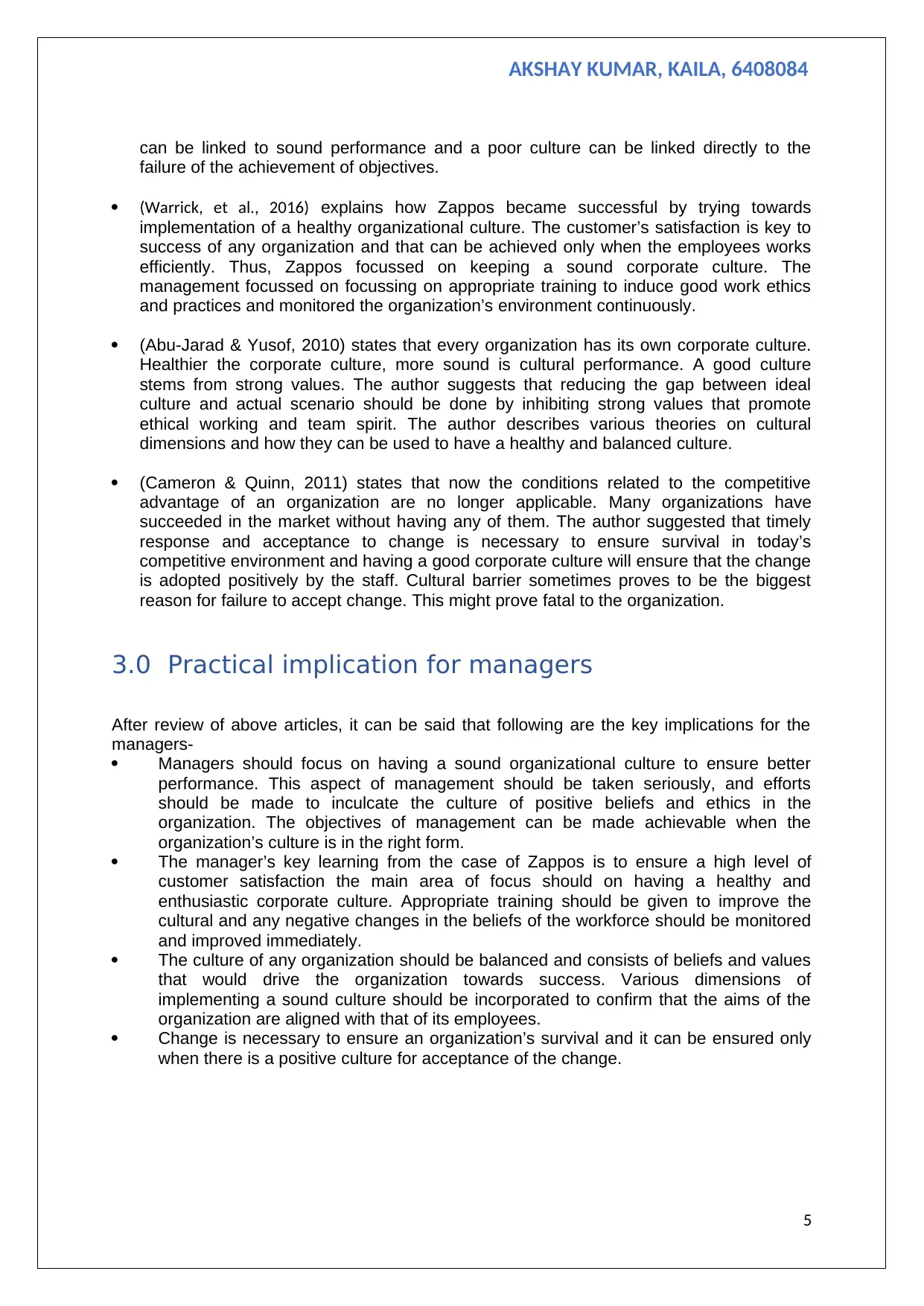
AKSHAY KUMAR, KAILA, 6408084
can be linked to sound performance and a poor culture can be linked directly to the
failure of the achievement of objectives.
(Warrick, et al., 2016) explains how Zappos became successful by trying towards
implementation of a healthy organizational culture. The customer’s satisfaction is key to
success of any organization and that can be achieved only when the employees works
efficiently. Thus, Zappos focussed on keeping a sound corporate culture. The
management focussed on focussing on appropriate training to induce good work ethics
and practices and monitored the organization’s environment continuously.
(Abu-Jarad & Yusof, 2010) states that every organization has its own corporate culture.
Healthier the corporate culture, more sound is cultural performance. A good culture
stems from strong values. The author suggests that reducing the gap between ideal
culture and actual scenario should be done by inhibiting strong values that promote
ethical working and team spirit. The author describes various theories on cultural
dimensions and how they can be used to have a healthy and balanced culture.
(Cameron & Quinn, 2011) states that now the conditions related to the competitive
advantage of an organization are no longer applicable. Many organizations have
succeeded in the market without having any of them. The author suggested that timely
response and acceptance to change is necessary to ensure survival in today’s
competitive environment and having a good corporate culture will ensure that the change
is adopted positively by the staff. Cultural barrier sometimes proves to be the biggest
reason for failure to accept change. This might prove fatal to the organization.
3.0 Practical implication for managers
After review of above articles, it can be said that following are the key implications for the
managers-
Managers should focus on having a sound organizational culture to ensure better
performance. This aspect of management should be taken seriously, and efforts
should be made to inculcate the culture of positive beliefs and ethics in the
organization. The objectives of management can be made achievable when the
organization’s culture is in the right form.
The manager’s key learning from the case of Zappos is to ensure a high level of
customer satisfaction the main area of focus should on having a healthy and
enthusiastic corporate culture. Appropriate training should be given to improve the
cultural and any negative changes in the beliefs of the workforce should be monitored
and improved immediately.
The culture of any organization should be balanced and consists of beliefs and values
that would drive the organization towards success. Various dimensions of
implementing a sound culture should be incorporated to confirm that the aims of the
organization are aligned with that of its employees.
Change is necessary to ensure an organization’s survival and it can be ensured only
when there is a positive culture for acceptance of the change.
5
can be linked to sound performance and a poor culture can be linked directly to the
failure of the achievement of objectives.
(Warrick, et al., 2016) explains how Zappos became successful by trying towards
implementation of a healthy organizational culture. The customer’s satisfaction is key to
success of any organization and that can be achieved only when the employees works
efficiently. Thus, Zappos focussed on keeping a sound corporate culture. The
management focussed on focussing on appropriate training to induce good work ethics
and practices and monitored the organization’s environment continuously.
(Abu-Jarad & Yusof, 2010) states that every organization has its own corporate culture.
Healthier the corporate culture, more sound is cultural performance. A good culture
stems from strong values. The author suggests that reducing the gap between ideal
culture and actual scenario should be done by inhibiting strong values that promote
ethical working and team spirit. The author describes various theories on cultural
dimensions and how they can be used to have a healthy and balanced culture.
(Cameron & Quinn, 2011) states that now the conditions related to the competitive
advantage of an organization are no longer applicable. Many organizations have
succeeded in the market without having any of them. The author suggested that timely
response and acceptance to change is necessary to ensure survival in today’s
competitive environment and having a good corporate culture will ensure that the change
is adopted positively by the staff. Cultural barrier sometimes proves to be the biggest
reason for failure to accept change. This might prove fatal to the organization.
3.0 Practical implication for managers
After review of above articles, it can be said that following are the key implications for the
managers-
Managers should focus on having a sound organizational culture to ensure better
performance. This aspect of management should be taken seriously, and efforts
should be made to inculcate the culture of positive beliefs and ethics in the
organization. The objectives of management can be made achievable when the
organization’s culture is in the right form.
The manager’s key learning from the case of Zappos is to ensure a high level of
customer satisfaction the main area of focus should on having a healthy and
enthusiastic corporate culture. Appropriate training should be given to improve the
cultural and any negative changes in the beliefs of the workforce should be monitored
and improved immediately.
The culture of any organization should be balanced and consists of beliefs and values
that would drive the organization towards success. Various dimensions of
implementing a sound culture should be incorporated to confirm that the aims of the
organization are aligned with that of its employees.
Change is necessary to ensure an organization’s survival and it can be ensured only
when there is a positive culture for acceptance of the change.
5
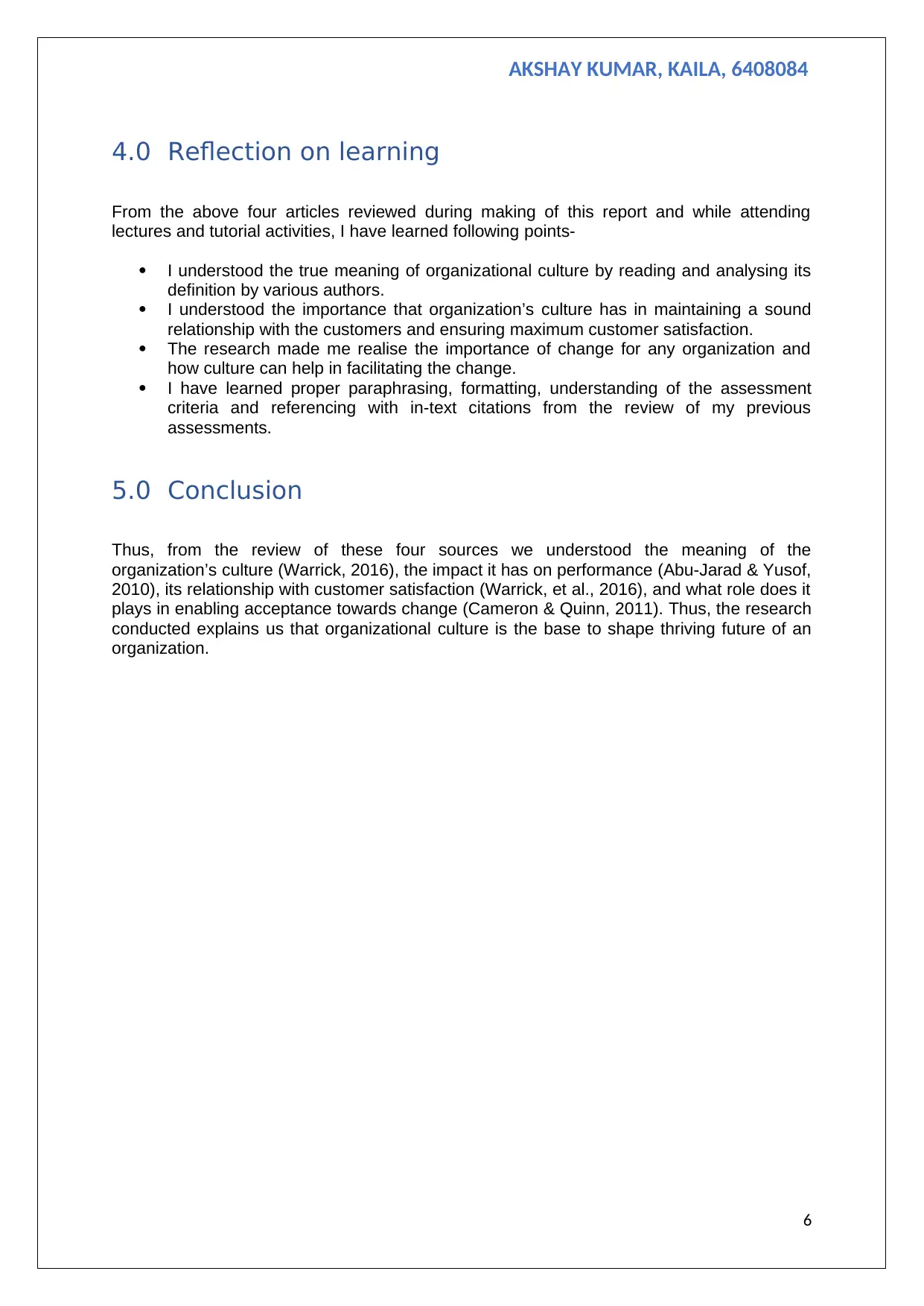
AKSHAY KUMAR, KAILA, 6408084
4.0 Reflection on learning
From the above four articles reviewed during making of this report and while attending
lectures and tutorial activities, I have learned following points-
I understood the true meaning of organizational culture by reading and analysing its
definition by various authors.
I understood the importance that organization’s culture has in maintaining a sound
relationship with the customers and ensuring maximum customer satisfaction.
The research made me realise the importance of change for any organization and
how culture can help in facilitating the change.
I have learned proper paraphrasing, formatting, understanding of the assessment
criteria and referencing with in-text citations from the review of my previous
assessments.
5.0 Conclusion
Thus, from the review of these four sources we understood the meaning of the
organization’s culture (Warrick, 2016), the impact it has on performance (Abu-Jarad & Yusof,
2010), its relationship with customer satisfaction (Warrick, et al., 2016), and what role does it
plays in enabling acceptance towards change (Cameron & Quinn, 2011). Thus, the research
conducted explains us that organizational culture is the base to shape thriving future of an
organization.
6
4.0 Reflection on learning
From the above four articles reviewed during making of this report and while attending
lectures and tutorial activities, I have learned following points-
I understood the true meaning of organizational culture by reading and analysing its
definition by various authors.
I understood the importance that organization’s culture has in maintaining a sound
relationship with the customers and ensuring maximum customer satisfaction.
The research made me realise the importance of change for any organization and
how culture can help in facilitating the change.
I have learned proper paraphrasing, formatting, understanding of the assessment
criteria and referencing with in-text citations from the review of my previous
assessments.
5.0 Conclusion
Thus, from the review of these four sources we understood the meaning of the
organization’s culture (Warrick, 2016), the impact it has on performance (Abu-Jarad & Yusof,
2010), its relationship with customer satisfaction (Warrick, et al., 2016), and what role does it
plays in enabling acceptance towards change (Cameron & Quinn, 2011). Thus, the research
conducted explains us that organizational culture is the base to shape thriving future of an
organization.
6
⊘ This is a preview!⊘
Do you want full access?
Subscribe today to unlock all pages.

Trusted by 1+ million students worldwide
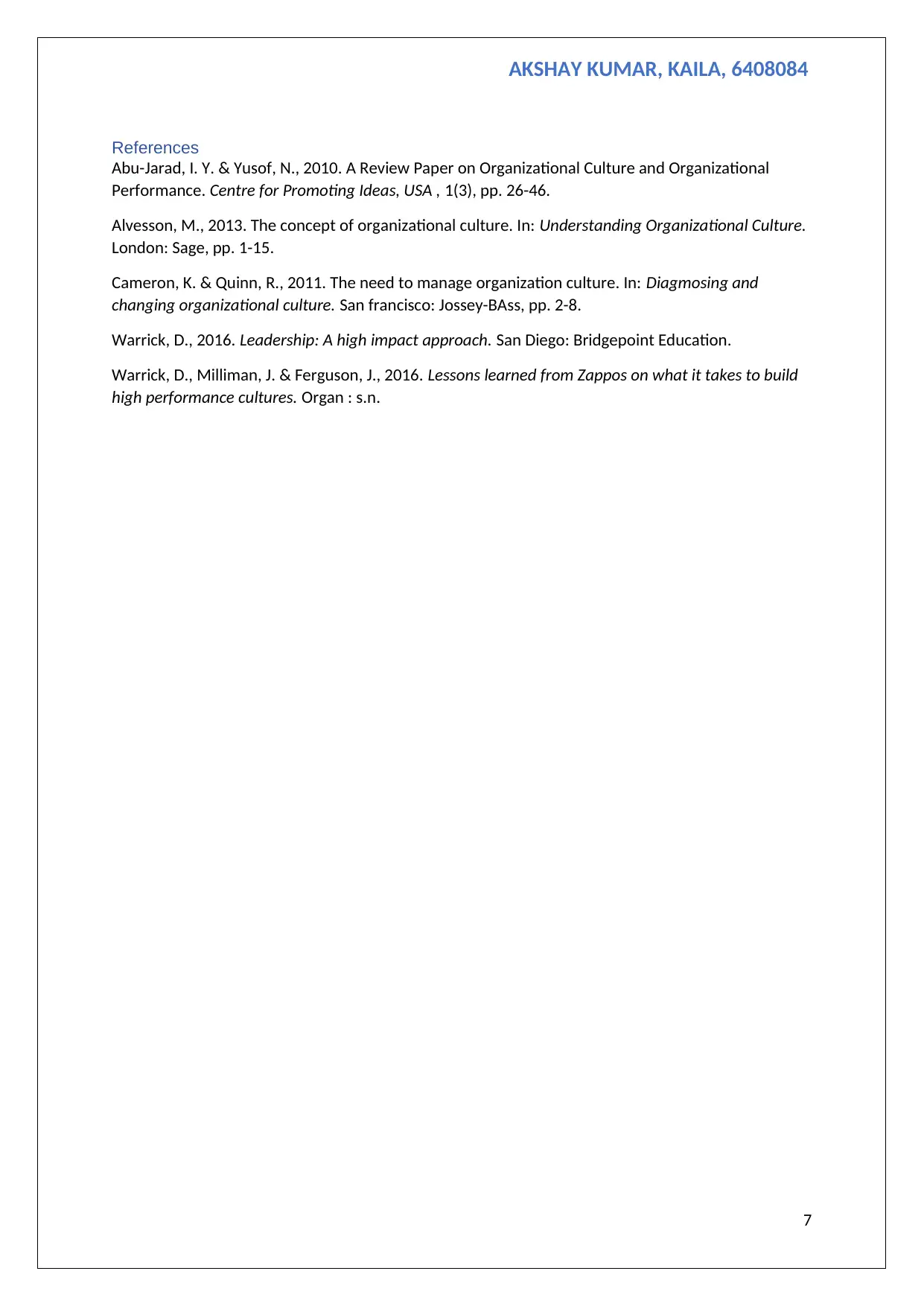
AKSHAY KUMAR, KAILA, 6408084
References
Abu-Jarad, I. Y. & Yusof, N., 2010. A Review Paper on Organizational Culture and Organizational
Performance. Centre for Promoting Ideas, USA , 1(3), pp. 26-46.
Alvesson, M., 2013. The concept of organizational culture. In: Understanding Organizational Culture.
London: Sage, pp. 1-15.
Cameron, K. & Quinn, R., 2011. The need to manage organization culture. In: Diagmosing and
changing organizational culture. San francisco: Jossey-BAss, pp. 2-8.
Warrick, D., 2016. Leadership: A high impact approach. San Diego: Bridgepoint Education.
Warrick, D., Milliman, J. & Ferguson, J., 2016. Lessons learned from Zappos on what it takes to build
high performance cultures. Organ : s.n.
7
References
Abu-Jarad, I. Y. & Yusof, N., 2010. A Review Paper on Organizational Culture and Organizational
Performance. Centre for Promoting Ideas, USA , 1(3), pp. 26-46.
Alvesson, M., 2013. The concept of organizational culture. In: Understanding Organizational Culture.
London: Sage, pp. 1-15.
Cameron, K. & Quinn, R., 2011. The need to manage organization culture. In: Diagmosing and
changing organizational culture. San francisco: Jossey-BAss, pp. 2-8.
Warrick, D., 2016. Leadership: A high impact approach. San Diego: Bridgepoint Education.
Warrick, D., Milliman, J. & Ferguson, J., 2016. Lessons learned from Zappos on what it takes to build
high performance cultures. Organ : s.n.
7
1 out of 7
Related Documents
Your All-in-One AI-Powered Toolkit for Academic Success.
+13062052269
info@desklib.com
Available 24*7 on WhatsApp / Email
![[object Object]](/_next/static/media/star-bottom.7253800d.svg)
Unlock your academic potential
Copyright © 2020–2025 A2Z Services. All Rights Reserved. Developed and managed by ZUCOL.




